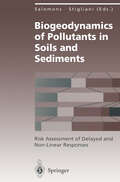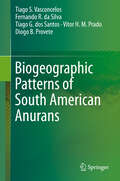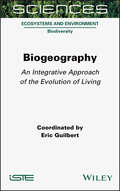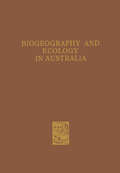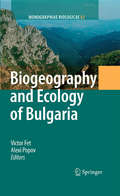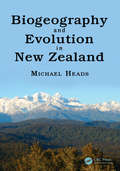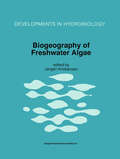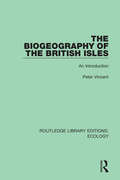- Table View
- List View
Biogeodynamics of Pollutants in Soils and Sediments: Risk Assessment of Delayed and Non-Linear Responses (Environmental Science and Engineering)
by William M. Stigliani WimSalomonsIn the USA, Western and Central Europe, there are many large-scale polluted sites that are too large to be cleaned up economically with available technologies. The pollution is caused by heavy industries to soils and sediments in waterways and reservoirs. Since these areas are expected to remain polluted for many years, it is necessary to take a long-term view to insure that the capacity to retain the contaminants is not diminished and to understand the potential for large-scale contaminant mobilization at these sites triggered by changing environmental conditions. This book provides information for predicting long-term changes and making risk assessments and describes the approach of geochemical engineering to handling large-scale polluted sites.
Biogeogens and Human Health (SpringerBriefs in Public Health)
by Niraj KumarHealth of the people is the most important indicator of the development of a nation. Health is a state of complete physical, mental and social well being and not merely the absence of disease or infirmity (as defined by WHO). The state of health of an individual or population depends upon complex interaction of the physical, biological, political and social domains. The environment affects the human health in a big way. People tend to be most susceptible to illness when physically or mentally stressed. Stress, energy and immunity form a closely knit network. Through his experimental findings, the author has brought out this intricate concept of interdependence of biotic (living) and abiotic (non-living) factors in an ecosystem, resulting in an impact on human health, in an explicitly marvelous manner. As a result, a new word “Biogeogens” has been coined, “bio” for living (biotic) , “geo” for non-living (abiotic/geographical/climatic/environment) and “gens” for the interactive proceeds of the two. The content included herein is directly concerned with the societal health and gives a clue to many socio-psycho health problems presently not handled with care. It also defines a multidimensional approach for dealing with many psychosomatic and health problems.
Biogeographic Patterns of South American Anurans
by Tiago S. Vasconcelos Fernando R. da Silva Tiago G. dos Santos Vitor H. Prado Diogo B. ProveteThis book analyzes different facets of anuran amphibian distribution in South America. We integrate alternative biological metrics employing cutting-edge methods to understand the dynamic processes underlying species distribution patterns. By using the modern biogeographic toolbox, we explore how richness gradients, phylogenetic diversity, functional diversity, and range size/endemism distribution of amphibians vary along the continent. Moreover, we present a robust proposal for priority areas for conservation of anurans in South America that maximizes representativeness of distinct biodiversity facets.
A Biogeographical Analysis of the Chihuahuan Desert through its Herpetofauna (Biogeographica #9)
by D.J. MorafkaThe Mexican Plateau, in its magnificent dimensions and material wealth, stood among the first and perhaps most alluring discoveries of European explorers. Bur ied deeper in the verbal histories of a now vanquished people, the American Indians, must be the primordial human awareness of the inverted complex triangle that dominates the Mexican topography, climate and biota. It always has been viewed by man as a source of wealth and a center of authority. The plateau is the pillar upon which all Mexican conquerors have erected their capitols, tilled their crops and mined for their treasure, and from which they dispersed the forces of their authority. Ironically, the same size and diversity that give the plateau its value, also make it an immense barrier. Its broad desert and three to five thousand meter high crests constitute severe obstacles in the path of North American man. What has just been said of mankind in general, can be applied to the biologist in particular. He too has termed the goliath southern plateau as the crucible of the arid biotas of the continent (i. e. , 'Madro-Tertiary'). The biologist found the plateau to be a region of tremendous richness and diversity. But he also has been inhibited both physically and intellectually by its high mountain and vast desert barriers.
Biogeography: An Integrative Approach of the Evolution of Living
by Eric GuilbertThe recent progress in analytical methods, aided by bringing in a wide range of other disciplines, opens up the study to a broader field, which means that biogeography now goes far beyond a simple description of the distribution of living species on Earth.Originating with Alexander von Humboldt, biogeography is a discipline in which ecologists and evolutionists aim to understand the way that living species are organized in connection with their environments. Today, as we face major challenges such as global warming, massive species extinction and devastating pandemics, biogeography offers hypotheses and explanations that may help to provide solutions.This book presents as wide an overview as possible of the different fields that biogeography interacts with. Sixteen authors from all over the world offer different approaches based on their specific areas of knowledge and experience; thus, we intend to illustrate the vast number of diverse aspects covered by biogeography.
Biogeography: An Integrative Approach of the Evolution of Living
by Eric GuilbertThe recent progress in analytical methods, aided by bringing in a wide range of other disciplines, opens up the study to a broader field, which means that biogeography now goes far beyond a simple description of the distribution of living species on Earth.Originating with Alexander von Humboldt, biogeography is a discipline in which ecologists and evolutionists aim to understand the way that living species are organized in connection with their environments. Today, as we face major challenges such as global warming, massive species extinction and devastating pandemics, biogeography offers hypotheses and explanations that may help to provide solutions.This book presents as wide an overview as possible of the different fields that biogeography interacts with. Sixteen authors from all over the world offer different approaches based on their specific areas of knowledge and experience; thus, we intend to illustrate the vast number of diverse aspects covered by biogeography.
Biogeography and Ecology in Antarctica (Monographiae Biologicae #15)
by J. Van Mieghem P. Van OyeThis book is the third in aseries of publications devoted to the biogeographieal and ecological research in the Southern Hemisphere, published in the "Monographiae Biologicae". After dealing with Australia (vol. VIII) and Southern Africa (Vol. XIV) it was thought essential to include Antarctiea in this series. Ever since the expedition of the "Belgiea" made the first suc cessful wintering within the antarctie circle in 1898 and brought back a very rieh harvest of scientific data, Belgium kept a vivid interest in Antarctiea and took an active part in the modern and international exploration of this vast continent. As part of their programs for the International Geophysieal Year (I. G. Y. ) twelve nations established permanent or semi-permanent bases on the Antarctie Continent or on subantarctie islands. Thus a new era of vast and free international scientific collaboration in the Antarctie was opened and it culminated in the formulation and the signing of the Antarctic Treaty (Washington 1959). It was recognized and accepted that "Antarctiea" shall be used for peaceful purposes only and "Freedom of scientific investigation in Antarctiea and coopera tion toward that end, as applied during the I. G. Y. , shall continue . . " In order to organize this collaboration e. g. by full exchange of programs and resuIts a "Special Committee on Antarctie Research" (S. C. A. R. ) was founded in 1957.
Biogeography and Ecology in Madagascar (Monographiae Biologicae #21)
by R. Battistini G. Richard-VindardBiogeography and Ecology in South America (Monographiae Biologicae #18)
by E. J. Fittkau J. Illies H. Klinge G. H. SchwabeWith 'Biogeography and Ecology in South America' as the general theme, a total of twenty-nine contributions by thirty authors is offered here in two volumes, being volumes 18 and 19 of the Monographiae Biologicae. Most of these discussions deal with decidedly specialist themes and the editors have been particularly concerned to ensure that the authors enjoyed the greatest possible freedom in the preparation of their work in order that different points of view and interpretations, together with some questions of controversy, may be clarified. This also applies, of course, to the several chapters in which general themes (geographical substance, climate, geology, vegetation, amongst others) are discussed. Since the amount of material available is too great to enable one to aspire to a presentation of the complete biogeographical and ecological picture, this procedure seems expedient. However, these two volumes could well be regarded as being a preparatory work for just such a complete description. Each of the separate technical contributions refers to the continent as a whole, in order to characterise it as such from the viewpoint of the specialist. For this reason it was necessary to forgo special discussions of particular regions or types of landscape, although South America of all places is remarkably rich in unique regional phenom ena, the altiplano of Peru and Bolivia, the relict forests of Fray Jorge, the shrub formations of Tierra del Fuego, the lakes of the High Andes, for example.
Biogeography and Ecology in Tasmania (Monographiae Biologicae #25)
by W. D. WilliamsDistribution and Range . . . 142 The Tasmanian Trout Fishery 153 Population Dynamics of Tench 163 Conservation Notes 167 Bibliography . . . . . . . . 168 VII. Littoral Biogeography by A. J. DARTNALL 171 Introduction . . . . . . . . . . . . . . 171 The Maugean Marine Province. . . . . . 175 Distribution Patterns of some Tasmanian Marine Animals 178 Conclusions. . . . 190 Acknowledgements 191 Bibliography . . . 191 VIII. The Zoogeography and Evolution of Tasmanian Oligochaeta by B. G. M. JAMIESON. . 195 Introduction . . . . . . . . . . . . 195 The Australian Region: A World Perspective 198 Earthworms and Continental Drift. . . . . 206 Tasmanian Earthworms - Relationships with the Australian Fauna. . . . . . . . . . . . . . . . . . . . . . . 210 Tasmanian Megasco1ecid Species and Aspects of their Evolution . 218 Bibliography . . . . . . . . . . . 226 IX. Oniscoidea (Terrestrial Isopoda) by ALISON J. A. GREEN . . . . . . . 229 Introduction . . . . . . . . . . . 229 Ecological Distribution. . . . . . . 229 Comments on Ecological Distribution 235 Geographical Distribution of Species Recorded from T- mania. . . . . . . . . . . . . . . . . . . . . . . 237 Geographical Distribution of Genera Recorded from T- mama. . . . . . 239 Acknowledgements 247 Bibliography . . . 247 X. The Amphibia of Tasmania by M. J. LITTLEJOHN and A. A. MARTIN 251 Introduction 251 Taxonomy. 251 Distribution 265 Biology . . 268 Zoogeography . . 272 Evolution . . . . 277 Acknowledgements 282 Bibliography . . . 282 Key 1: Key to Frogs (Adults) . 286 Key 2: Key to Male Mating Calls . 287 Key 3: Key to Eggs. . 288 Key 4: Key to Tadpoles . . . . . 289 XI. Biogeography and Ecology of the Reptiles of Tasmania and the Bass Strait Area by P. A. RAWLINSON. 291 Introduction . . . . . . . . . . . . . . . 291 Cainozoic Climates and Pleistocene Sea Levels. 292 Present Climate. . . . . . . . . . . . . . 297 Ecological Requirements of Reptiles. . . . . 299 The Reptile Fauna of Tasmania and the Bass Strait Area - Composition, Ecology and Distribution. . . .
Biogeography and Ecology in the Canary Islands (Monographiae Biologicae #30)
by G. KunkelWhen asked by the General Editor to prepare a book-length treatment concerning the nature of the Canary Islands, our aims were rather ambitious. A general monograph was to be written, embracing all the disciplines of natural history applicable to these islands, and over twenty scientists were approached for contributions. However scientists are 'time machines' ; our proposed list of contents has changed a good many times. Cooporation of other authors was gained and, finally, a fairly rounded project appeared revealing different and lesser known aspects of Canary Island Nature. Since Centuries the Canary Islands have attracted the attention of travellers. Earliest reports may be traced back some two thousand years but real scientific investigation began about 1800, the time of Alexander von Humboldt and his visit to the islands; older reports are scarce, sometimes rather confusing because of geographic inaccuracies. But the 19th Century will remain as the century of fundamental explorations, connected with names such as Leopold von Buch, F. C. MacGregor, Sabin Berthelot, Philip Barker Webb, J. Viera y Clavijo, F. von Fritsch, C. Bolle, D. H. Christ, O. Simony, G. Hartung, H. Mayer etc. , all familiar and intimately connected with our knowledge of the natural history of the archipelago. Even the much criticised Ernst Haeckel has provided us with lively descriptions of his visit to one of the 'Fortunate Islands'. The 20th Century brought new interest, new fields to be explored, and new expeditions to the islands.
Biogeography and Ecology of Bulgaria (Monographiae Biologicae #82)
by Victor Fet Alexi PopovFrom single-celled organisms in Black Sea sand to endemic cave crustaceans, from mountain glacial relict insects to the most diverse bird fauna in Europe, the fauna of Bulgaria has been a subject of study for more than a century. This is the first English language survey of all vertebrate and many key invertebrate groups of Bulgaria, their faunistics, origin, geographical and ecological distribution, and conservation issues.
Biogeography and Ecology of New Guinea (Monographiae Biologicae #42)
by J. L. GressitJ. L. Gressitt New Guinea is a fantastic island, unique and fascinating. It is an area of incredible variety of geomorphology, biota, peoples, languages, history, tradi tions and cultures. Diversity is its prime characteristic, whatever the subject of interest. To a biogeographer it is tantalizing, as well as confusing or frustrating when trying to determine the history of its biota. To an ecologist, and to all biologists, it is a happy hunting ground of endless surprises and unanswered questions. To a conservationist it is like a dream come true, a "flash-back" of a few centuries, as well as a challenge for the future. New Guinea is so special that it is hard to compare it with other islands or tropical areas. It is something apart, with its very complicated history (chapters I: 2-4, II: 1-4, III: I, VI: I, 2). It is partly old but to a great extent very young, yet extremely rich and complex. It has biota of different sources - to such a degree that it is still disputed in this volume as to what Realm it belongs to: the Paleotropical or Notogaean (Australian); or what Region: Oriental, "Oceanic," Papuan or Australian. The terms Papuasian, Indo-Australian and Australasian also have been applied to the area.
Biogeography and Ecology of Southern Africa (Monographiae Biologicae #31)
by Marinus J. A. Werger A. C. Van BruggenSouthern Africa is certainly not a naturally bounded area so that there are several possibilities for delineating it and concepts about its extent. Wellington* discussed the various possibilities for delineation and suggested that one line stands out more clearly and definitely as a physical boundary than any other, namely the South Equatorial Divide, the watershed between the ZaIre, Cuanza and Rufiji Rivers on the one hand and the Z ambezi, Cunene and Rovuma Rivers on the other. This South Equatorial Divide is indeed a major line of separation for some organisms and is also applicable in a certain geographical sense, though it does not possess the slightest significance for many other groups of organisms, ecosystems or geographical and physical features of Africa. The placing of the northern boundary of southern Africa differs in fact strongly per scientific dis cipline and is also influenced by practical considerations regarding the possibilities of scientific work as subordinate to certain political realities and historically grown traditions. This is illustrated, for example, in such works as the Flora of Southern Africa, where the northern boundary of the area is conceived as the northern and eastern political boundaries of South West Africa, South Africa and Swaziland. Botswana, traditionally included in the area covered by the Flora Zambesiaca, thus forms a large wedge in 'Southern Africa'.
Biogeography and Ecology of the Pityusic Islands (Monographiae Biologicae #52)
by K. Kuhbièr J. A. Alcover Guerau C. D'Arellano TurA large part of this book is dedicated to the geology of the Pityusic Archipelago, followed by contributions on climate and geography. Funguses, mosses and leeks are the subjects of taxonomical botany, and a further paper deals with the vegetation of the islands. Another large part of this book is concerned with zoology: faunal lists on fleas, bees, wasps, ants, butterflies, beetles, snails, amphibians and reptiles, birds and mammals, the latter with their epi- and endofaunas as well as their subfossil remains are presented in 13 different papers. Three of them deal with the special problems of isolation and evolution of new races on rocks and small islets: tenebrionid beetles, lizards and terrestrial snails. Man, as an important factor in the Pityusic Islands, is dealt with in six contributions: prehistory, which means pre-Phoenician and which is treated for the first time, folk architecture, the 'endemic' dialect of the Catalonian language, exploitation of some natural resources and finally the problems of inbreeding and related matters on Formentera. The book closes with an outlook on the present state of the Pityusic nature and tries to show ways of conserving all important parts of the archipelago, so that 'our' two islands may preserve some of their typical vegetation, plants and animals and, thus, of their character.
Biogeography and Ecology of Turkmenistan (Monographiae Biologicae #72)
by V. Fet Khabibulla Atamuradovremnants of gene pools of these species. Badghyz Natural Reserve, established in 1941, became a refuge for the last existing population of the Turkmen onager (Equus hemionus onager) and a unique pistachio woodland. A new generation oflocal Turkmen scientists, many of whom were trained by the Russian researchers in the graduate schools of Moscow and Leningrad arose from the 1930s through the 1950s. The Turkmen Academy of Sciences and its journal, Proceedings (including the monthly biological series), served to record the results of diverse biological studies in the republic. While basic science in the Middle Asian republics rather gained from the Russian "colonial" influence, natural resources, in contrast, were severely damaged by the Soviet way of handling the economy and social issues. Severe environmental problems have been inherited by the now independent Turkmenistan, including overgrazed desert pastures, deforested mountains, depleted water resources, accumulated pesticides in cotton fields, declining populations of endangered species of animals and plants, and - worst of al- progressing, human-caused desertification (Kharin this volume). In order to approach a solution to these problems, scientists and officials in the republic will need the close attention and help of the international scientific community.
Biogeography and Evolution in New Zealand (CRC Biogeography Series)
by Michael HeadsBiogeography and Evolution in New Zealand provides the first in-depth treatment of the biogeography of New Zealand, a region that has been a place of long-enduring interest to ecologists, evolutionary scientists, geographers, geologists, and scientists in related disciplines. It serves as a key addition to the contemporary discussion on regionalization—how is New Zealand different from the rest of the world? With what other areas does it share its geology, history, and biota? Do new molecular phylogenies show that New Zealand may be seen as a biological ‘parallel universe’ within global evolution?
Biogeography and Evolution in New Zealand (CRC Biogeography Series #1)
by Michael HeadsBiogeography and Evolution in New Zealand provides the first in-depth treatment of the biogeography of New Zealand, a region that has been a place of long-enduring interest to ecologists, evolutionary scientists, geographers, geologists, and scientists in related disciplines. It serves as a key addition to the contemporary discussion on regionalization—how is New Zealand different from the rest of the world? With what other areas does it share its geology, history, and biota? Do new molecular phylogenies show that New Zealand may be seen as a biological ‘parallel universe’ within global evolution?
Biogeography and Taxonomy of Honeybees
by Friedrich RuttnerHoneybees are as small as flies or as large as hornets, nesting in nar row cavities of trees and rocks or in the open on large limbs of trees 30 m above ground. They occur in tropical zones and in the forests of the Ural mountains, they survive seven months of winter and even longer periods of drought and heat. Historically, they lived through a extended time of stagnation in the tropics from the mid-Tertiary, but then experienced an explosive evolution during the Pleistocene, re sulting in the conquest of huge new territories and the origin of two dozen subspecies in Apis mellifera. This vast geographic and ecologic diversification of the genus Apis was accompanied by a rich morphological variation, less on the level of species than at the lowest rank, the subspecies level. Variation being exclusively of a quantitative kind at this first step of speciation, tradi tional descriptive methods of systematics proved to be unsatisfactory, and honeybee taxonomy finally ended up in a confusing multitude of inadequately described units. Effective methods of morphometric-sta tistical analysis of honeybee popUlations, centered on limited areas, have been developed during the last decades. Only the numerical characterization of the populations, together with the description of behavior, shows the true geographic variability and will end current generalizations and convenient stereotypes.
Biogeography of Freshwater Algae (Developments in Hydrobiology #118)
by Jørgen KristiansenThis book is based on a workshop on biogeography of freshwater algae held during the Fifth International Phycological Congress in China 1994. A group of outstanding specialists covering widely different approaches to the subject have been brought together, and this collection of their contributions forms a unique volume: there is no other book on the subject. It thus fills an evident gap in the phycological literature, and will be of major interest to researchers and teachers within phycology, limnology, and evolutionary biology. However, it may also be useful in courses for advanced students.
Biogeography of Mycorrhizal Symbiosis (Ecological Studies #230)
by Leho TedersooThis book offers a timely overview and synthesis of biogeographic patterns of plants and fungi and their mycorrhizal associations across geographic scales. Written by leading experts in the field, it provides an updated definition of mycorrhizal types and establishes the best practices of modern biogeographic analyses. Individual chapters address the basic processes and mechanisms driving community ecology, population biology and dispersal in mycorrhizal fungi, which differ greatly from these of prokaryotes, plants and animals. Other chapters review the state-of-the-art knowledge about the distribution, ecology and biogeography of all mycorrhizal types and the most important fungal groups involved in mycorrhizal symbiosis. The book argues that molecular methods have revolutionized our understanding of the ecology and biogeography of mycorrhizal symbiosis and that rapidly evolving high-throughput identification and genomics tools will provide unprecedented information about the structure and functioning of mycorrhizal symbiosis on a global scale. This volume appeals to scientists in the fields of plant and fungal ecology and biogeography.
The Biogeography of the British Isles: An Introduction (Routledge Library Editions: Ecology #17)
by Peter VincentOriginally published in 1990, The Biogeography of the British Isles is devoted to the biogeography of the British Isles and surrounding shelf seas. Bringing together a wealth of diverse information, it is thoroughly referenced and well illustrated, and will be invaluable to students of geography, environmental science, ecology, botany, and zoology. The book traces the development of British biogeography over the last two centuries, examining key topics such as ecosystems, habitats, and niches in the context of plant and animal distribution. The book gives a detailed account of the development of biogeographical mapping and recording systems, and describes modern-day distributions, both in the countryside and in urban areas against the backcloth of human activities.
The Biogeography of the British Isles: An Introduction (Routledge Library Editions: Ecology #17)
by Peter VincentOriginally published in 1990, The Biogeography of the British Isles is devoted to the biogeography of the British Isles and surrounding shelf seas. Bringing together a wealth of diverse information, it is thoroughly referenced and well illustrated, and will be invaluable to students of geography, environmental science, ecology, botany, and zoology. The book traces the development of British biogeography over the last two centuries, examining key topics such as ecosystems, habitats, and niches in the context of plant and animal distribution. The book gives a detailed account of the development of biogeographical mapping and recording systems, and describes modern-day distributions, both in the countryside and in urban areas against the backcloth of human activities.
